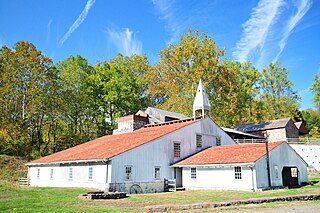
Hopewell Furnace National Historic Site in southeastern Berks County, near Elverson, Pennsylvania, is an example of an American 19th century rural iron plantation, whose operations were based around a charcoal-fired cold-blast iron blast furnace. The significant restored structures include the furnace group (blast furnace, water wheel, blast machinery, cast house and charcoal house), as well as the ironmaster's house, a company store, the blacksmith's shop, a barn and several worker's houses.
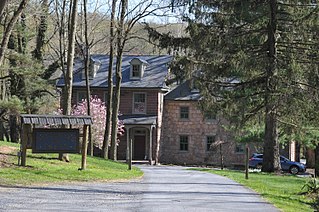
Speedwell Forge Mansion, also known as Speedwell Forge Homestead, is a historic home located at Elizabeth Township, Lancaster County, Pennsylvania. The ironmaster's mansion was built about 1760, and is a 2½-story, four bay wide and two bay deep, brownstone and fieldstone dwelling in the Georgian style. It was expanded about 1795 with a Georgian/Federal style wing. Also on the property are a contributing stone summer kitchen, stone and frame workshop, stone paymaster's office c. 1795), and stone privy.
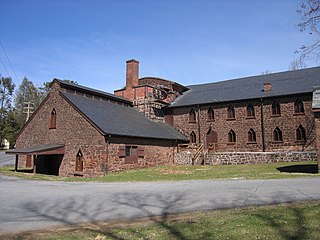
Cornwall Iron Furnace is a designated National Historic Landmark that is administered by the Pennsylvania Historical and Museum Commission in Cornwall, Lebanon County, Pennsylvania in the United States. The furnace was a leading Pennsylvania iron producer from 1742 until it was shut down in 1883. The furnaces, support buildings and surrounding community have been preserved as a historical site and museum, providing a glimpse into Lebanon County's industrial past. The site is the only intact charcoal-burning iron blast furnace in its original plantation in the western hemisphere. Established by Peter Grubb in 1742, Cornwall Furnace was operated during the Revolution by his sons Curtis and Peter Jr. who were major arms providers to George Washington. Robert Coleman acquired Cornwall Furnace after the Revolution and became Pennsylvania's first millionaire. Ownership of the furnace and its surroundings was transferred to the Commonwealth of Pennsylvania in 1932.

The Coventryville Historic District is a historic district and historic village in Chester County, Pennsylvania, United States that enjoyed a significant role in the early American metal industry.
The Grubb Family Iron Dynasty was a succession of iron manufacturing enterprises owned and operated by Grubb family members for more than 165 years. Collectively, they were Pennsylvania's leading iron manufacturer between 1840 and 1870.

Isabella Furnace was a cold blast charcoal iron furnace located in West Nantmeal Township, Pennsylvania. The furnace was named for Isabella Potts, wife of one of the partners, a member of the Potts ironmaking family. Isabella was the last iron furnace to be built in the county, in 1835, and was operated by members of the Potts family and their partners until 1855, when they lost control of it in a bankruptcy. It returned to the family in 1881, when it was purchased by Col. Joseph Potts, who modernized it. The furnace, the last to operate in Chester County, went out of blast in 1894, a few months after Col. Potts' death, but remained largely intact until after his son's death in 1943. The remains of the furnace complex have been listed in the National Register of Historic Places since 1991.

Etna Furnace, also known as Mount Etna Furnace, Aetna Furnace, and Aetna Iron Works, is a historic iron furnace complex and national historic district located at Catharine Township, Blair County, Pennsylvania. The district includes five contributing buildings, six contributing sites, and two contributing structures. It encompasses a community developed around an iron furnace starting in 1805. Included in the district is the four-sided stone furnace (1808), gristmill site, canal locks, site of lock keeper's house, aqueduct, two small houses, the ruins of a charcoal house (1808), the foundation of a tally house, a blacksmith shop, bank barn, foundation of a boarding house, three family tenant houses, two iron master mansions, a store and paymaster's office, Methodist / Episcopal Church (1860), and cemetery with graves dating between 1832 and 1859.

Huntingdon Furnace is a national historic district and historic iron furnace and associated buildings located at Franklin Township in Huntingdon County, Pennsylvania. It consists of seven contributing buildings and one contributing structure. They are the iron furnace, office building, the ironmaster's mansion, log worker's house, a residence, the farm manager's residence, the grist mill and the miller's house. The iron furnace was moved to this site in 1805, from its original site one mile upstream. It measures 30 feet square by 30 feet high. The ironmaster's mansion was built in 1851, and is a 2+1⁄2-story, L-shaped frame dwelling. The grist mill dates to 1808, and is a 3+1⁄2-story, rubble stone building measuring 50 feet by 45 feet. The furnace was in operation from 1796, until it ceased operations in the 1880s.

Barree Forge and Furnace, now known as Greene Hills Methodist Camp, is a national historic district located at Porter Township in Huntingdon County, Pennsylvania. It consists of two contributing buildings, one contributing site, and one contributing structure associated with a former ironworks. They are the ironmaster's mansion, furnace stack, a barn, and the site of the Barree iron forge built about 1797. The ironmaster's mansion was built in the 1830s, and is a 2 1/2-story brick house painted white. The furnace stack dates to 1864, and is a 30-foot square, coursed limestone structure. It measures between 6 and 15 feet tall. The ironworks closed in the 1880s. The property was acquired in 1963, by the United Methodist Church for use as a church camp.

The Paradise Furnace, also known as the Mary Anne Furnace, is a national historic district that is located in Trough Creek State Park in Todd Township in Huntingdon County, Pennsylvania.

Shade Furnace Archeological District, also known as Old Shade Furnace and Shade Forge, is a national historic district located at Shade Township in Somerset County, Pennsylvania. The district includes four contributing sites and two contributing objects. It encompasses the ruins of a countryside plantation style iron forge operation that operated from 1808 to 1858. It includes a stone blast furnace structure, a forge site, an ore pit site, a farmstead site, and a late 19th-century coal mine complex. The area includes a number of archaeological sites associated with the ruins of abandoned buildings.
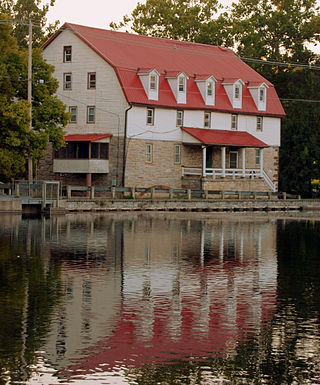
Boiling Springs Historic District is a national historic district located at Boiling Springs, Cumberland County, Pennsylvania. The district includes 127 contributing buildings, 1 contributing site, and 1 contributing structure associated with its role as an early iron manufacturing center and surrounding residential areas of Boiling Springs. Most of the contributing buildings date to the mid-19th century starting in 1845, with a few dated to the early period of development. The oldest buildings are a grist mill, the ironmaster's, Michael Ege, mansion (1795), and the restored Boiling Springs Tavern (1832). Other notable non-residential buildings include the former stone stables (1829) and forge building (1850s). Residential areas include notable examples of the Bungalow/craftsman, Late Victorian, and Federal styles. The contributing structure is a stone three-arched bridge (1854).
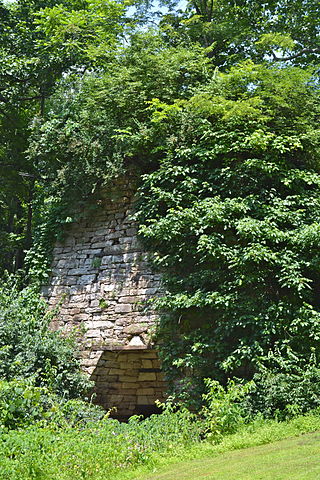
Franklin Furnace Historic District is a national historic district located in St. Thomas Township, Franklin County, Pennsylvania. The district includes five contributing buildings, one contributing structure, and one contributing site associated with a 19th-century iron furnace plantation. The buildings are the manager's house/office and four workers' houses. The structure is the furnace stack (1828). It measures 30 feet square at the base and approximately 30 feet tall. The contributing site is the ruins of a barn. The furnace ceased full operation in 1882.

Poole Forge is an historic, American iron forge complex and national historic district that is located in Narvon, Caernarvon Township, Lancaster County, Pennsylvania.

Windsor Forge Mansion, also known as Windsor Place, is an historic, American home and national historic district located in Caernarvon Township, Lancaster County, Pennsylvania.

Chickies Historic District is a national historic district located at East Donegal Township, West Hempfield Township, and Marietta, Lancaster County, Pennsylvania, United States. The district includes 32 contributing buildings, 16 contributing sites, and four contributing structures in three areas. They are: 1) floodplain along the Susquehanna River containing archaeological remains of iron furnaces; 2) the "Ironmasters' Hill" area of Marietta with five residences associated with ironmasters ; and 3) the Donegal Creek area with farmland, iron pits, and limestone quarries owned by the ironmasters.

The Swatara Furnace is a historic iron furnace and 200-acre national historic district located along Mill Creek, a tributary of the Swatara Creek in Pine Grove Township, Schuylkill County, Pennsylvania.
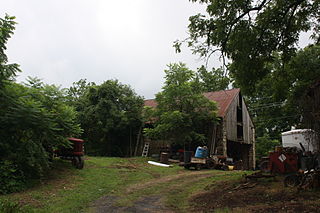
Dale Furnace and Forge Historic District, also known as Dale Iron Works and Mt. Chalfont Furnace, is a historic "iron plantation" and national historic district located in Washington Township, Berks County, Pennsylvania. The district encompasses six contributing buildings and one contributing site. They are a stone horse barn, stone and frame bank barn, ironmaster's mansion, smokehouse and wash house (1827), stone worker's house (1830), and counting house. The archaeological site includes the ruins of a worker's house, the stone furnace stack, bank iron furnace, forge foundations and race, and remnants of dam breast. The furnace remained in blast until about 1822, and the Dale Forge was in operation until 1868.

The Robesonia Furnace Historic District, also known as the Reading Furnace and the Robesonia Iron Co. Ltd., is an historic, American iron plantation and national historic district that is located in Robesonia, Berks County, Pennsylvania.
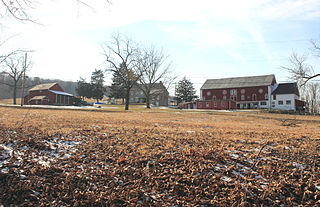
The Mary Ann Furnace Historic District, also known as Trexler's Furnace, is an historic iron plantation and national historic district located in Longswamp Township in Berks County, Pennsylvania.























